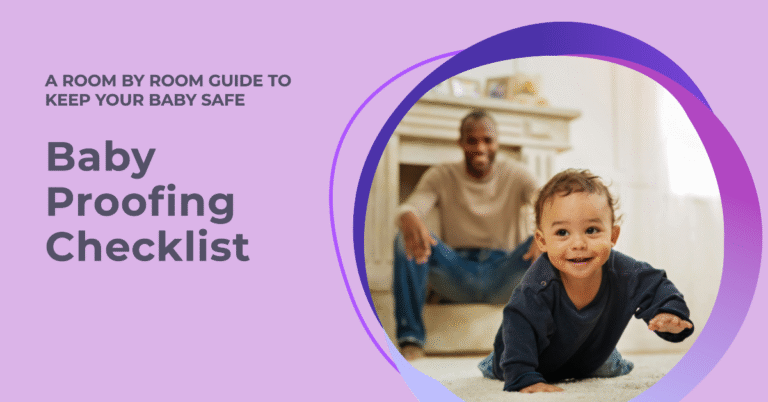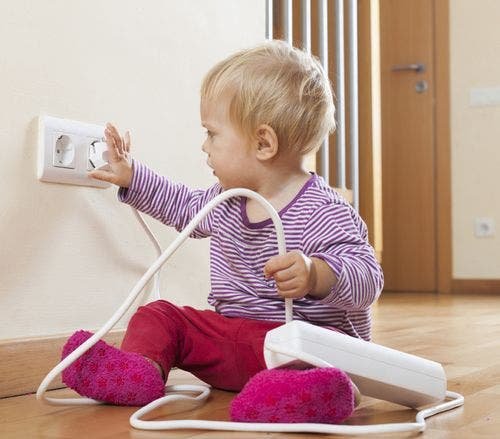When Can You Stop Using Baby Gates? Expert Age & Safety Tips
As a parent, your child’s safety is always your top priority. You’ve probably relied on baby gates to keep your little explorer safe as they crawl and toddle around the house.
But as your child grows, you might wonder: when is it safe to stop using these gates? Understanding the right time to remove baby gates can be tricky, and making the wrong decision could lead to accidents. You want to ensure your home remains a safe haven while also giving your child the freedom they need to explore and develop.
In this post, we’ll guide you through the age and safety tips for removing baby gates, helping you strike the perfect balance between safety and independence. Keep reading to discover when you can confidently say goodbye to baby gates and hello to peace of mind.
Purpose Of Baby Gates
Baby gates are essential for every home with young children. They create a safe environment by restricting access to dangerous areas. These gates act as barriers to protect curious toddlers. A simple tool, yet so effective. Parents use them to block stairs, kitchens, or rooms with hazards.
Why Are Baby Gates Important?
Children love to explore every corner of the house. Their curious nature often leads them to risky places. Baby gates prevent access to these unsafe areas. They help in avoiding accidents and injuries. Gates ensure peace of mind for parents. Knowing their child is safe is priceless.
Types Of Baby Gates
Various types of baby gates are available. Pressure-mounted gates are easy to install. They don’t require drilling or screws. Wall-mounted gates offer extra security. They are ideal for top-of-stair use. Some gates are even adjustable. Parents can choose based on their home needs.
When To Use Baby Gates
Install baby gates as soon as your child starts crawling. They are useful until your child understands safety. Often, this is around 2-3 years old. Regularly check the gates for stability. Ensure they are secure and functioning properly.
Choosing The Right Baby Gate
Consider the area where you will install the gate. Measure the width to ensure a proper fit. Check the gate’s height to prevent climbing. Look for gates with easy-to-use latches. Read reviews and safety ratings for peace of mind.
Maintaining Baby Gates For Safety
Regularly inspect the gates for wear and tear. Tighten any loose parts immediately. Clean the gates to keep them hygienic. Teach older children not to climb or tamper with gates. Consistent maintenance ensures long-term safety.
Key Safety Considerations
Deciding when to remove baby gates depends on your child’s age and ability to navigate stairs safely. Typically, children around two years old can move without gates, but each child’s development varies. Regularly assess their skills and ensure the environment remains secure.
When you start thinking about removing baby gates, it’s crucial to consider safety. Baby gates are more than just barriers; they are essential tools that protect your child from potential hazards. Ensuring your child’s safety is the priority, and understanding the key safety considerations can help you make informed decisions. Let’s dive into some important aspects you should focus on.Preventing Falls
Falls are a common risk for young children who are still mastering their balance and coordination. Baby gates are effective in preventing falls by blocking access to stairs and other elevated areas. Have you noticed how fast toddlers can move? It’s like a blink of an eye, and they are off exploring. To reduce the risk of falls, keep the gates securely attached. Check them regularly to make sure they aren’t loose. A friend once shared how her son managed to wiggle a gate loose; it was a close call. Regular checks can prevent such heart-stopping moments. Think about the areas in your home where falls are most likely. Stairs are an obvious one, but also consider balconies or even sunken living rooms. The more you anticipate, the safer your child will be.Restricting Hazardous Areas
It’s not just about stairs. Baby gates are useful for keeping curious kids away from dangerous areas. Kitchens, bathrooms, and garages are full of potential hazards. Sharp tools, cleaning supplies, and heavy equipment are just a few examples. Have you ever walked into the kitchen only to find your little one trying to open the oven? A well-placed gate can prevent these mishaps. Identify the high-risk zones in your home and restrict access with gates. Consider other areas like home offices where cords and small objects can pose a danger. A friend’s toddler once got hold of a paperclip and tried to eat it. Gates can help keep little explorers out of harm’s way. As your child grows, their ability to understand and avoid danger improves. But until then, these practical measures ensure peace of mind. What areas in your home need a little extra safeguarding?Developmental Milestones
Understanding when to remove baby gates is crucial for safety. As your child grows, they reach developmental milestones. These milestones help you decide when gates are no longer necessary. Evaluating these stages ensures your child’s environment is safe. Let’s explore some key milestones.
Crawling And Walking
Babies start crawling around six to ten months. This milestone signals increased mobility. Crawling means your child can reach more areas. This mobility requires careful monitoring. Once your child begins walking, usually around twelve months, their ability to navigate changes. Walking means they can move faster and reach higher places. This stage might require more supervision.
Climbing Abilities
Climbing abilities develop after walking. Children often start climbing around eighteen months. This milestone indicates a new level of exploration. Climbing means they can reach places previously inaccessible. As climbing skills improve, the need for gates might change. Consider their climbing abilities when assessing safety. Gates might be necessary for a bit longer. Removing gates should coincide with their ability to understand boundaries.
Credit: www.cityofaventura.com
Age Recommendations
Understanding age recommendations for baby gates is crucial for child safety. Baby gates help prevent accidents by keeping little ones away from danger. Parents often wonder when to stop using them. Let’s explore age recommendations for different stages.
Infants And Toddlers
Babies begin to crawl around six months. At this stage, baby gates become essential. They prevent access to stairs and unsafe areas. Use gates until your child walks confidently. This usually happens around 2 years. But each child is different. Observe their motor skills and curiosity levels.
Preschool And Beyond
By age three, many children can handle stairs. Their coordination improves significantly. Some families still use gates as a precaution. Especially in homes with steep stairs or multiple floors. Assess your child’s ability and home layout. This helps decide if gates are still needed. Discuss safety rules with older children too. Teaching them awareness is crucial for their safety.
Signs Your Child Is Ready
Parents often wonder when to remove baby gates. Watch for your child’s balance and ability to follow safety rules. Typically, kids aged two or three show readiness, but individual development varies.
As parents, determining when your child is ready to stop using baby gates is a significant milestone. It’s not just about age; it’s about recognizing the right signs. These signs help ensure your child’s safety while fostering their independence. Are you wondering if your child is ready? Let’s explore what to look for.Understanding Boundaries
One sign that your child is ready to move beyond baby gates is their understanding of boundaries. Can they recognize areas that are off-limits without a barrier? If your child consistently stays away from stairs or restricted areas when reminded, it’s a good indicator. Consider your own experiences. Has your child learned to stop at the top of the stairs without needing a gate? This demonstrates a developing sense of spatial awareness and self-control. Observing this behavior can reassure you about their readiness.Responding To Verbal Cues
Another key sign is how well your child responds to verbal cues. Do they listen and follow your instructions reliably? If your child can stop, wait, or change direction when asked, they might be ready to navigate without baby gates. Think about daily interactions. Is your child able to stop when you say “wait” or “come back”? This responsiveness shows they’re developing the ability to process and act on verbal guidance, which is crucial for their safety and independence. It’s important to assess these signs carefully. Each child develops at their own pace, and your intuition as a parent is invaluable. As you observe these behaviors, ask yourself: Is my child ready for this next step?
Credit: www.bfhd.wa.gov
Transitioning Safely
Deciding when to remove baby gates depends on your child’s development. Most parents consider this around age two. Always ensure the child’s ability to navigate stairs safely before removing gates.
Transitioning from using baby gates to allowing your child more freedom in the home is a significant milestone. It’s not just about removing a barrier; it’s about preparing your child—and yourself—for a new stage of independence. This transition requires careful planning, keen observation, and a touch of patience. How do you know when it’s time to take down those baby gates, and how can you ensure safety as your child roams free?Gradual Removal
Start by removing baby gates in less critical areas of your home. You might begin with hallways or rooms where your child is already familiar and comfortable. Observe how your child navigates these spaces without the gate’s barrier. Make sure to maintain supervision during this trial period. Notice if your child respects boundaries or if there are potential hazards you need to address. This gradual approach allows both you and your child to adjust without overwhelming changes.Introducing House Rules
As you phase out baby gates, establishing clear house rules becomes essential. Use simple language to explain these rules to your child. “We walk slowly near the stairs,” or “We stay away from the kitchen when Mommy is cooking” are examples of straightforward guidelines. Consistency is key. Reinforce these rules regularly and involve your child in the conversation. Ask them to repeat the rules back to you, ensuring they understand. This not only enhances safety but also empowers your child to be part of their own safety process. Remember when you first introduced the baby gates? It was a learning curve for both you and your little one. The transition away from them is no different. Embrace this new chapter with confidence and curiosity, creating a safe space for your child’s exploration and growth. Are there specific strategies you’ve found helpful in easing this transition? Share your thoughts and experiences below!Common Mistakes To Avoid
Parents often wonder when to stop using baby gates. Many make mistakes by removing them too early. Safety experts recommend keeping gates until children can navigate stairs confidently, typically around 2 years old.
When it comes to ensuring your child’s safety, baby gates play a crucial role during their early years. However, the transition from using baby gates to allowing your child more freedom can be tricky. Many parents make common mistakes that can compromise safety. Understanding these pitfalls can help you make better decisions for your child’s well-being.Rushing The Process
Many parents are eager to reclaim their space and remove baby gates too soon. It’s tempting to think, “My child is walking confidently now, so they must be ready.” Yet, even confident walkers can be unsteady and curious, leading to potential mishaps. Remove gates only when your child can navigate stairs and other obstacles safely. Observe them as they play and explore to gauge their readiness. Have you considered if they understand boundaries and dangers, like not climbing furniture?Ignoring Individual Differences
Every child grows at their own pace. Some might be ready to move freely at 18 months, while others might need more time. Your friend’s toddler might have outgrown the baby gate phase, but that doesn’t mean your child is ready. Consider your child’s personality and behavior. Are they adventurous or cautious? An adventurous child might need gates longer to prevent them from exploring unsafe areas. Reflect on your child’s unique needs instead of following generic age guidelines. Ensuring safety involves understanding these common mistakes. By taking your time and considering your child’s individual development, you can make informed decisions that keep them safe and happy.Expert Tips For Parents
Parents often wonder when it’s safe to remove baby gates. Typically, by age two or three, children can navigate stairs more safely. Regularly assess your child’s climbing skills and maturity. Always ensure stair safety to prevent accidents.
Ensuring the safety of your little one is a top priority, especially when they’re on the move. Baby gates serve as a crucial barrier during their early years, but when do you know it’s time to remove them? With expert tips, you can make informed decisions that balance freedom and safety for your child. Let’s explore some practical advice from professionals to help you make the best choice for your family.Consulting Pediatricians
Pediatricians are invaluable resources when it comes to your child’s development and safety. They offer insights tailored to your child’s specific growth milestones. Have you asked your pediatrician about the right time to stop using baby gates? Your child’s physical abilities and behavioral maturity are key factors. A pediatrician can provide guidance based on their unique development. You might find that your child’s climbing skills or ability to understand boundaries influence this decision.Customizing To Your Home
Every home is different, and so are the challenges each space presents. Consider the layout of your home and identify areas that require continued restriction. Are there stairs, kitchens, or bathrooms that still pose a risk? Baby gates might still be necessary in certain areas, even if your child has outgrown the need in others. Evaluate each area individually to determine if a gate is still a good idea. Personal experiences often reveal that certain spots, like a home office, can benefit from a gate long after others have been removed. Remember, your home is unique, just like your family. Tailor safety measures to your specific environment and needs. This customization ensures that you’re not only keeping your child safe but also fostering their independence at an appropriate pace.
Credit: www.amazon.com
Frequently Asked Questions
What Age Can You Remove Baby Gates?
Baby gates can typically be removed when a child is around 2 years old. By this age, they usually have better coordination and understanding of boundaries. However, always assess your child’s abilities and the specific risks in your home before removing gates.
Are Baby Gates Necessary For All Homes?
Baby gates are essential if you have stairs or unsafe areas. They’re particularly important for homes with toddlers who are exploring. Even in a single-level home, they help section off rooms. Evaluate your home’s layout and potential hazards to determine your specific needs.
How Do I Choose The Right Baby Gate?
Choose a baby gate based on your home’s layout and your child’s age. Pressure-mounted gates are ideal for doorways and less risky areas. Hardware-mounted gates are best for top-of-stairs. Always ensure the gate meets safety standards and is easy for adults to operate.
How Can I Ensure My Baby Gate Is Safe?
Regularly check your baby gate for any signs of wear or damage. Make sure it’s securely installed according to the manufacturer’s instructions. Ensure the latch functions properly, and never leave it partially open. Always supervise your child around gates to prevent climbing or tampering.
Conclusion
Baby gates provide essential safety for curious toddlers. Parents should assess their child’s ability to navigate stairs or risky areas. Trust your instincts about their readiness. Remove gates gradually for your child’s independence. Supervise them closely during this transition phase.
Consider using other safety measures if needed. Encourage your child to be cautious near stairs. Regularly remind them about safety rules. Every child develops at their own pace. Stay patient and adjust safety measures as necessary. Prioritize your child’s well-being during this important stage.
A safe environment helps children grow confidently and securely.




